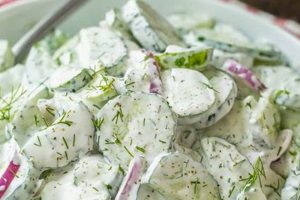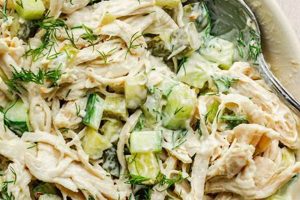A combination of cooked chicken, mayonnaise, and seasonings, often including celery and onion, forms the base of this classic dish. The addition of dried cranberries introduces a sweet-tart element that complements the savory flavors and adds a pleasant textural contrast. Variations may include different types of mayonnaise, herbs, spices, nuts, and fruits. A typical preparation involves combining shredded or diced chicken with the chosen ingredients and serving the mixture chilled on bread, crackers, or lettuce wraps.
This dish offers a versatile and convenient meal option, suitable for picnics, lunches, or light dinners. The protein from the chicken provides satiety, while the cranberries contribute antioxidants and a touch of sweetness. Historically, chicken salad emerged as a popular dish in the mid-19th century, adapting to available ingredients and culinary trends over time. The incorporation of cranberries reflects a more modern twist, capitalizing on the berry’s growing popularity and health benefits.
Further exploration will delve into various recipe options, including classic preparations, healthier alternatives, and creative variations showcasing different flavor profiles and dietary considerations. Techniques for achieving optimal texture and flavor will also be discussed, along with suggestions for presentation and serving.
Tips for a Superior Chicken Salad with Cranberries
Achieving optimal flavor and texture requires attention to detail. The following tips offer guidance for creating a chicken salad that stands out.
Tip 1: Chicken Selection and Preparation: Opt for high-quality chicken, either roasted, poached, or baked. Avoid pre-cooked or processed chicken for best results. Allow the chicken to cool completely before shredding or dicing to prevent a mushy texture.
Tip 2: Cranberry Choice: Dried cranberries are recommended, preferably sweetened or Craisins. Rehydrate dried cranberries by soaking them briefly in warm water or juice for a plumper texture.
Tip 3: Mayonnaise Matters: Use good quality mayonnaise. Consider experimenting with different types, such as light mayonnaise or a mixture of mayonnaise and plain yogurt for a lighter flavor profile.
Tip 4: Flavor Balancing: Balance the sweetness of the cranberries with savory elements. Incorporate Dijon mustard, lemon juice, or a pinch of salt to enhance the overall flavor complexity.
Tip 5: Textural Enhancement: Add textural interest through ingredients like chopped celery, pecans, walnuts, or red onion. Toasting the nuts before adding them elevates their flavor.
Tip 6: Chilling Time: Allow the chicken salad to chill for at least 30 minutes before serving. This allows the flavors to meld and enhances the overall experience.
Tip 7: Bread Selection: Choose bread that complements the chicken salad. Croissants, whole-wheat bread, or multigrain bread are excellent options. Toasting the bread adds a crisp contrast to the creamy filling.
By following these tips, one can create a chicken salad with cranberries that offers a delightful balance of flavors and textures, ensuring a satisfying culinary experience. These considerations contribute to a dish that transcends the ordinary and becomes a true culinary delight.
The following section will offer a selection of recipes that incorporate these tips, showcasing the versatility and adaptability of this classic dish.
1. High-Quality Chicken
High-quality chicken plays a crucial role in a successful cranberry chicken salad sandwich. It forms the foundation of the dish, influencing both flavor and texture. Tender, flavorful chicken elevates the overall experience, while dry, bland chicken can detract significantly. Chicken quality impacts how well it absorbs and complements other ingredients. Superior chicken offers a clean, neutral canvas for other flavors to shine without competing or clashing.
Consider the difference between using freshly roasted chicken breast versus pre-cooked, processed chicken. The roasted chicken offers a richer, more nuanced flavor and a satisfying texture, allowing the sweetness of the cranberries and the savory notes of other seasonings to stand out. Conversely, pre-cooked chicken often carries a processed flavor that can overpower the delicate balance of the salad. Similarly, choosing free-range or organic chicken can further enhance the flavor profile, contributing to a more wholesome and satisfying final product. The enhanced flavor of higher-quality chicken contributes directly to the overall enjoyment of the sandwich, making it a worthwhile investment.
Understanding the importance of high-quality chicken allows for informed choices that directly affect the final outcome. While using pre-cooked chicken might offer convenience, opting for higher-quality alternatives ultimately delivers a superior sensory experience. This understanding empowers consumers to prioritize quality ingredients and optimize their culinary creations. The connection between chicken quality and the overall enjoyment of the sandwich underscores the importance of thoughtful ingredient selection in achieving culinary excellence.
2. Sweet-tart Cranberries
The incorporation of sweet-tart cranberries elevates the traditional chicken salad sandwich, introducing a dynamic interplay of flavors and textures. This addition offers a counterpoint to the richness of the mayonnaise and the savory notes of the chicken, creating a more complex and balanced flavor profile. The cranberries’ inherent sweetness is tempered by their tartness, preventing an overly saccharine taste and adding a refreshing brightness. Furthermore, the chewy texture of the cranberries provides a pleasing contrast to the softer textures of the chicken and mayonnaise, contributing to a more engaging sensory experience. Consider, for instance, a classic chicken salad made solely with mayonnaise, celery, and onion. While palatable, it can often lack a defining element. The introduction of cranberries immediately brightens the flavor, adding a distinct character that distinguishes it from other chicken salad variations.
This seemingly simple addition has significant practical implications. The sweet-tart element introduced by cranberries broadens the appeal of the sandwich, catering to a wider range of palates. The cranberries also contribute a vibrant color, enhancing the visual appeal of the salad. From a nutritional perspective, cranberries offer a source of antioxidants and vitamins, further enhancing the health benefits of the dish. Moreover, the inclusion of cranberries allows for greater culinary creativity, opening doors for complementary flavors and textures such as pecans, walnuts, or orange zest. Imagine a chicken salad sandwich featuring cranberries alongside toasted pecans and a hint of orange zest. The combined flavors and textures create a symphony of taste, showcasing the versatility of this simple addition.
In conclusion, the integration of sweet-tart cranberries into a chicken salad sandwich represents a significant enhancement to a classic dish. This addition not only diversifies the flavor profile but also introduces textural complexity and nutritional value. The ability of this ingredient to transform a simple chicken salad into a more dynamic and appealing culinary experience underscores the power of thoughtful ingredient selection in crafting exceptional cuisine. The success of this combination highlights the potential for continuous innovation within traditional culinary frameworks.
3. Balanced Seasonings
Balanced seasonings are essential for a successful chicken salad sandwich recipe with cranberries. The inherent sweetness of the cranberries necessitates careful consideration of other flavor components to prevent an overly sweet or one-dimensional profile. Seasonings provide depth, complexity, and balance, ensuring the dish offers a harmonious blend of sweet, savory, and acidic notes. A lack of seasoning can result in a bland or unbalanced final product, whereas excessive seasoning can overpower the delicate flavors of the chicken and cranberries. For example, a chicken salad with cranberries might include Dijon mustard for tang, black pepper for subtle heat, and a pinch of salt to enhance the overall flavors. The Dijon mustard provides acidity to cut through the richness of the mayonnaise, while the black pepper adds a layer of complexity without overwhelming the palate. The salt, used judiciously, amplifies the existing flavors and brings them into harmony.
Consider the impact of omitting a key seasoning component. Without the acidity of the mustard, the sweetness of the cranberries might become dominant, resulting in a cloying flavor. Similarly, neglecting the salt could leave the salad tasting flat and underdeveloped. Conversely, an overabundance of any single seasoning could create an imbalance, detracting from the overall enjoyment. Too much Dijon mustard could make the salad excessively tart, while an overzealous hand with the black pepper could overwhelm the other subtle flavors. The interplay of these seasonings is crucial; they work synergistically to create a balanced and flavorful experience. One could also consider adding fresh herbs like dill or chives to provide an additional layer of freshness and complexity. These herbs complement the cranberries and other seasonings, further enhancing the overall flavor profile.
Achieving a harmonious balance of seasonings requires careful consideration of the other ingredients and their respective flavor profiles. The sweetness of the cranberries, the richness of the mayonnaise, and the savory notes of the chicken must all be taken into account when selecting and proportioning seasonings. This understanding allows for the creation of a chicken salad sandwich that is not only flavorful but also nuanced and well-balanced. The careful orchestration of these elements transforms a simple combination of ingredients into a cohesive and satisfying culinary experience. This attention to detail elevates the dish beyond mere sustenance, demonstrating a commitment to culinary excellence.
4. Textural Complexity
Textural complexity contributes significantly to the overall enjoyment of a chicken salad sandwich with cranberries. A combination of textures creates a more engaging and satisfying sensory experience. The creamy base of mayonnaise, typically smooth and rich, benefits from contrasting textures. Consider the addition of chopped celery, which introduces a crisp, refreshing element. This counterpoint prevents the salad from becoming monotonous and adds a vegetal note that complements the sweetness of the cranberries. Similarly, incorporating toasted nuts, such as pecans or walnuts, provides a satisfying crunch and nutty flavor, further enhancing the textural diversity. The cranberries themselves, plump and slightly chewy, offer yet another layer of textural intrigue.
The interplay of these varying textures elevates the dish beyond a simple combination of ingredients. Imagine biting into a sandwich where the creamy mayonnaise meets the crisp celery, followed by the burst of a juicy cranberry and the satisfying crunch of a pecan. This dynamic interplay of textures keeps the palate engaged and stimulates the senses. Without this textural complexity, the sandwich might feel one-dimensional and lack the depth that transforms it into a truly enjoyable culinary experience. One can further enhance this complexity by using a variety of ingredients, such as diced apples for a sweet crunch or water chestnuts for a delicate crispness. The choice of bread also plays a role; a crusty baguette or a seeded multigrain bread can add another dimension to the textural profile.
Understanding the importance of textural complexity empowers culinary exploration and innovation. Strategic ingredient selection allows for a carefully crafted balance of textures, ensuring a more satisfying and memorable dining experience. This principle extends beyond chicken salad; it applies to a wide range of culinary creations where a combination of textures contributes significantly to the overall appeal. A conscious awareness of textural interplay enables the creation of dishes that delight the senses and elevate everyday meals into memorable culinary experiences. This attention to detail distinguishes a thoughtfully prepared dish from a merely adequate one, demonstrating a commitment to culinary excellence.
5. Appropriate Bread
Bread selection significantly impacts the overall enjoyment of a chicken salad sandwich with cranberries. The bread acts as both a vessel and a complement to the filling, influencing the sandwich’s structural integrity, flavor profile, and textural experience. Choosing an appropriate bread enhances the interplay of flavors and textures, creating a harmonious and satisfying culinary experience. An unsuitable bread choice, however, can detract from the carefully crafted balance of the chicken salad, leading to a less enjoyable outcome. The following facets highlight key considerations for selecting the ideal bread.
- Structural Integrity:
The bread must be sturdy enough to hold the chicken salad without becoming soggy or falling apart. A delicate bread might crumble under the weight of the filling, resulting in a messy and unsatisfying eating experience. Conversely, a bread with a robust structure, such as sourdough or a dense whole-wheat loaf, provides a stable foundation for the salad, ensuring the sandwich maintains its integrity. Consider a croissant, for instance; its flaky, delicate structure makes it unsuitable for a moist filling like chicken salad. A baguette, on the other hand, offers the necessary strength to contain the filling while contributing a satisfying chewiness.
- Flavor Compatibility:
The bread’s flavor should complement, not compete with, the chicken salad. A neutral-flavored bread, such as white or whole wheat, allows the flavors of the chicken, cranberries, and seasonings to shine. Alternatively, a bread with a more pronounced flavor, like rye or pumpernickel, can add another layer of complexity to the overall profile, provided it harmonizes with the existing flavors. A strongly flavored bread might overwhelm the delicate balance of a subtly seasoned chicken salad. Conversely, a bland bread might fail to enhance a more robustly flavored salad. A sourdough bread, with its characteristic tang, could complement the sweetness of the cranberries and the savory notes of the chicken.
- Textural Contrast:
The bread’s texture contributes to the overall sensory experience. A crusty bread offers a pleasing contrast to the creamy filling, creating an interplay of textures that enhances enjoyment. A softer bread, while comfortable to bite into, might lack the textural contrast that elevates the sandwich. Consider a ciabatta roll with its airy interior and crisp crust; it provides a textural counterpoint to the creamy chicken salad, making each bite more dynamic. A soft white bread, while palatable, might not offer the same level of textural intrigue.
- Visual Appeal:
While often overlooked, the bread’s visual appeal contributes to the overall presentation. A well-shaped loaf or roll with an attractive crust enhances the sandwich’s aesthetic appeal, making it more enticing. A visually appealing bread can elevate a simple sandwich into a more visually satisfying experience. A rustic boule, for instance, with its irregular shape and golden crust, presents a more visually appealing option than a uniformly sliced sandwich loaf. This visual element, while not directly impacting flavor, contributes to the overall perception and enjoyment of the dish.
The careful selection of bread elevates the chicken salad sandwich with cranberries from a simple meal to a more considered culinary creation. Each facet, from structural integrity to visual appeal, contributes to the overall experience. A thoughtful approach to bread selection demonstrates an appreciation for the nuances of flavor, texture, and presentation, resulting in a more satisfying and enjoyable meal. The interplay of these elements highlights the importance of considering all components of a dish, even those seemingly as simple as the bread, to achieve culinary excellence.
Frequently Asked Questions
This section addresses common inquiries regarding chicken salad sandwiches incorporating cranberries, offering concise and informative responses.
Question 1: What type of chicken is best suited for this recipe?
Rotisserie chicken offers convenience and flavor, but any cooked chicken, such as baked or poached, works well. Avoid pre-cooked, processed chicken as it often lacks flavor and desirable texture.
Question 2: Can fresh cranberries be substituted for dried cranberries?
While fresh cranberries can be used, they possess a significantly higher tartness and different texture. Adjusting the sweetness level and chopping the cranberries finely is recommended if using fresh cranberries.
Question 3: How can one reduce the overall calorie content of this sandwich?
Substituting Greek yogurt for a portion of the mayonnaise, using whole-wheat bread, and incorporating more vegetables like celery or bell peppers can reduce calorie content without sacrificing flavor.
Question 4: How long can chicken salad with cranberries be stored in the refrigerator?
Properly stored in an airtight container, chicken salad can be refrigerated for up to three days. Ensure the chicken is thoroughly chilled before incorporating it into the salad.
Question 5: What are some alternative ingredients that complement cranberries in chicken salad?
Pecans, walnuts, apples, grapes, celery, red onion, and fresh herbs like dill or tarragon pair well with cranberries in chicken salad, offering varying textures and flavor profiles.
Question 6: Can this chicken salad be served without bread?
Absolutely. Chicken salad with cranberries can be enjoyed as a stand-alone salad, served on lettuce cups, or used as a filling for wraps or croissants.
Addressing these common questions provides a comprehensive understanding of preparing and enjoying chicken salad with cranberries. Thoughtful consideration of these points ensures optimal results and a satisfying culinary experience.
The next section will explore various recipe variations, catering to different tastes and dietary preferences.
Conclusion
This exploration of chicken salad enriched with cranberries has illuminated key aspects of its preparation and enjoyment. Emphasis on high-quality chicken, the balanced interplay of sweet and tart flavors from the cranberries, the judicious use of seasonings, the importance of textural complexity, and the strategic selection of appropriate bread contribute significantly to a superior culinary outcome. Each element plays a crucial role in the final product, demonstrating the interconnectedness of ingredients and techniques in achieving a harmonious and satisfying dish.
Culinary success hinges on a comprehensive understanding of these elements. Thoughtful consideration of each component, from ingredient selection to presentation, elevates this seemingly simple dish to a more nuanced and rewarding experience. The potential for creativity within this classic framework remains vast, inviting further exploration and adaptation to individual preferences and dietary considerations. Ultimately, the pursuit of culinary excellence lies in the careful orchestration of flavors, textures, and presentation, transforming a basic recipe into a truly memorable culinary creation.






